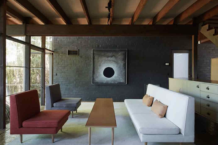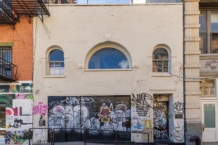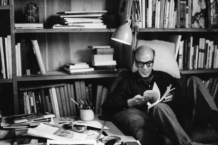The Greatest Piece of Automotive Design in History?
Design, Open Musings - by Ben Musu
Restaurateur and car-nut Ben Musu on why the Porsche 911 must be considered the single greatest piece of automotive design in history.
This column will work like this; I’m going to make a blanket statement, and by the time you’ve all read it, you’ll all agree.
The Porsche nine-eleven is the single greatest piece of automotive design to ever see the light of day.
Before clicking the “back” button on your browser I’d like to cite the distinction between design and styling, as I’m not about to suggest that it’s the best-styled car ever. Style is a matter of opinion – it’s entirely in the eye of the beholder
My suggestion is that Porsche’s 911, first known as the 901 at its launch in 1963, is the greatest piece of car design and evolution known to date. I say this because no other car has ever shown a production life of 50 years without an entire re-style or re-engineering of its basic foundation
Bear in mind that the 911’s predecessor, the Porsche 356, was a four-cylinder machine and that it was within its own line of evolution, only really a very good development of the Volkswagen Beetle discipline. So, when the good men at Stuttgart realised that making it faster or more practical or indeed possibly more “1960s” was going to be a bridge too far, they knew it would have to be replaced. And it had to be replaced with a car that would go faster, eclipse it in dynamic terms, broaden Porsche’s audience and yet remain faithful to the idea of what a Porsche was, and would become.
Enter the 901. It carried two adults up front, with a pair of occasional seats for either a contortionist, or more practically, one or two children. This was possible because like the 356 with its four-cylinder unit, it had its two-litre, six-cylinder engine mounted outboard of the rear axle line offering not only that internal space, but the rear-end traction that had already proven to make the Volkswagen and earlier Porsches sure-footed and safe in inclement conditions.
The engine gave it brisk rather than neck-snapping performance but by comparison to its contemporaries then, which were mostly four-cylinder sports cars powered by bread-and-butter engines borrowed from sedans, the Porsche was fairly rapid and an instant hit. Its practicality as a coupé was nearly unmatched, given its modest external dimensions. The space ahead of the cabin was a useful “boot” and there were plenty of places inside to stow odds and ends. Not to mention those seats in the back – they folded flat for your naughty-weekend suitcase or a place to carry the spare set of wheels for your Aston Martin.
The location of the engine gave rise to criticism in the early years because a bunch of ham-fisted journos accused it of being an ill-handling creature, and that its engine-out-the-back design was a fundamental flaw. However, during those formative years from ‘63 to ‘68 it got wider wheels and tyres and a slightly longer wheelbase. It got lower and slightly wider, making it easier to hustle and more stable – particularly when more power came along. Two litres grew to 2.2, then 2.4 and in 1973, 2.7 litres. In the latter part of the seventies the three-litre engine was launched and successively the 3.2 in 1984. By 1990, there was a 3.6 litre engine which has since grown to 3.8 litres. All this was also punctuated in the late seventies by the three and 3.3 litre Turbo, a facet of the model that secured it as a threat to the traditional, multi-cylinder super-cars regarded as the norm by proper enthusiasts and schoolboys alike.
All through its life, regardless of the specification of any particular model, the 911 was a quality car. Unlike many British rag-tops that fell to pieces and Italian coupes that decomposed before their warranty was up, the 911 was properly tough. From the sixties when it was a completely new and different concept, through the seventies when it became much faster and gained a huge following as a bona-fide racing car and into the eighties when it gained some ridiculous addenda and became the obvious choice for the best (and the dodgiest) of the well-heeled yuppies, the 911 has always been a car that you could live with. Air conditioning, fuel injection, a removable roof panel, a full cabriolet version, an engine that didn’t over-heat or refuse to start and the Sportomatic gearbox which gave buyers the option to have a 911 with no clutch pedal – these were all reasons that the car was so incredibly popular. The 911 is still built today as almost anyone who doesn’t live under a rock should know. When, in 1998 the engine became water-cooled for the sake of noise regulations many suggested that its best days as a design were behind it but it still continued to evolve, and is still a car that can be driven to the shops for a bottle of milk and then conversely be pushed around a circuit or a decent piece of mountainous back-road to the utter joy of its driver.
It has taken me the best part of thirty-five years to realise all this though, I must admit. My utter fascination for the model has arrived via many miles of driving – in traffic as well as at seven-tenths and as a passenger on the knife’s-edge. The unburstable two-litre engine screams its head off, a 2.7 Carrera wills you to wring its neck and wake entire suburbs, and the three-litre blub-blubs along on a crack of throttle. They aaaaall seem to stick like glue to the black-top and they all stop on a twenty cent piece. And did I mention they’re bloody tough. Some people complain about trickily-shifting gearboxes and the “intrusive noise from the engine whilst cruising” but these people have either jumped straight out of a Prius or have far too little else in life to worry about. And, and, and – that shape! Never more has form followed function. The 911’s sheet metal is stretched over a handful of points to conceal the mechanicals, enclose the occupants and very little else, is surely one of the most functionalist designs to clothe a performance car, more significantly a mass-production performance car. It has become so recognisable that few people don’t instantly recognise it.
And I’m thrilled now that in conclusion, and from reading this everybody agrees with my opening – the Porsche 911 is the car for all reasons and for all seasons. Clichéd as it reads and sounds, no car has held its development curve in the same way. And I wont be swayed.
By Ben Musu
Restaurateur, aesthetic observer and car-nut
Instagram @bennymusu








